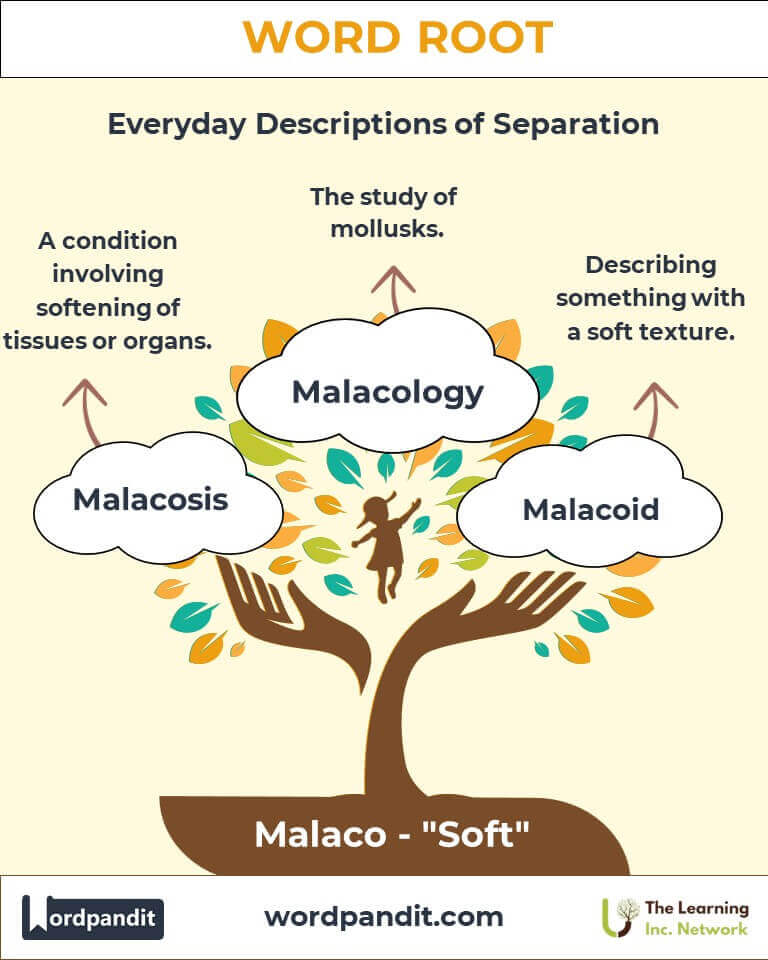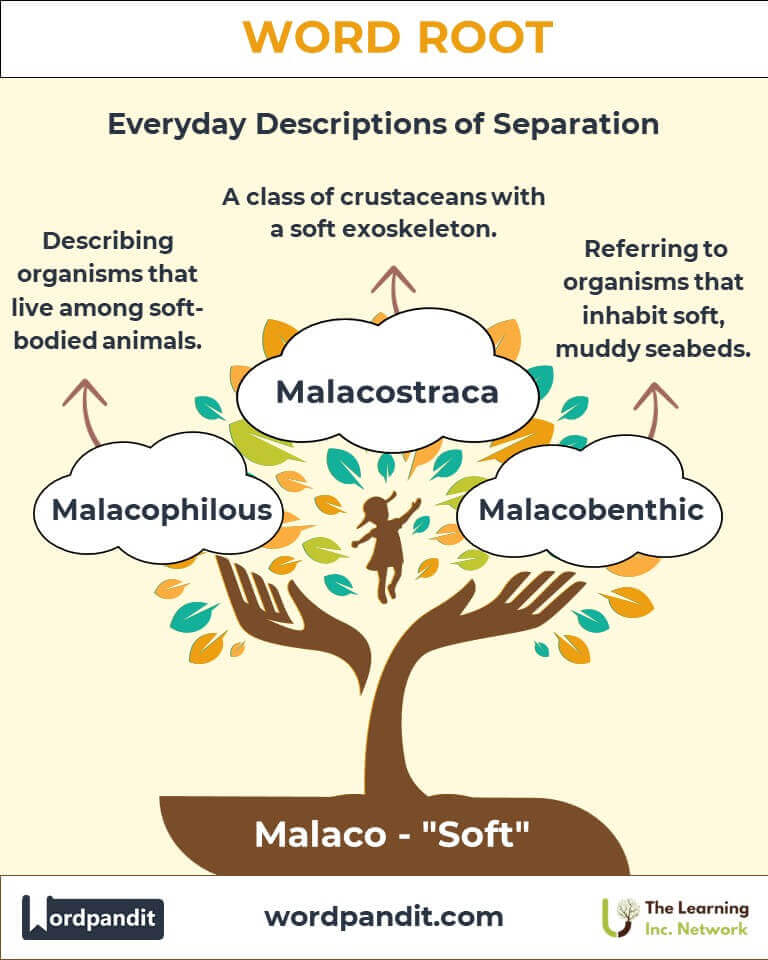Malaco: The Root of Softness in Science and Nature
Uncover the fascinating world of "malaco," a root word derived from Greek meaning "soft." From malacology, the study of mollusks, to malacopterygian, describing soft-finned fish, this root reveals the interconnected beauty of softness in nature and science.

Table of Contents
- Introduction: The Essence of "Malaco"
- Etymology and Historical Journey
- Mnemonic: Unlocking the Power of "Malaco"
- Common "Malaco"-Related Terms
- "Malaco" Through Time
- "Malaco" in Specialized Fields
- Illustrative Story: "Malaco" in Action
- Cultural Significance of "Malaco"
- The "Malaco" Family Tree
- FAQs about the "Malaco" Word Root
- Test Your Knowledge: "Malaco" Word Root Quiz
- Conclusion: The Living Legacy of "Malaco"
Introduction: The Essence of "Malaco"
What do mollusks and soft-finned fish have in common? The answer lies in the word root "malaco," pronounced ma-luh-koh, derived from the Greek malakos, meaning "soft." This root has enriched scientific terminology, particularly in biology, to describe organisms with soft bodies or soft physical traits. Its relevance spans disciplines, providing insight into the natural world's diversity.

Etymology and Historical Journey
The root "malaco" traces back to the Greek word malakos (soft). Ancient Greeks used the term metaphorically and literally to describe tenderness, pliability, or yielding characteristics. Over time, this root permeated scientific nomenclature, becoming foundational in malacology (the study of mollusks) and ichthyology, particularly in reference to malacopterygian fish.
Its evolution reflects humanity's enduring fascination with softness in nature.
Mnemonic: Unlocking the Power of "Malaco"
Imagine a soft, delicate mollusk resting on a beach, its gentle curves embodying the essence of softness. To recall "malaco," think:
Mnemonic Device: "Malaco means soft, like a mollusk’s touch."
Common "Malaco"-Related Terms
- Malacology (mal-uh-kol-uh-jee):
The scientific study of mollusks.
Example: "Her malacology research revealed new insights into snail habitats." - Malacopterygian (mal-uh-kop-ter-ij-ee-uhn):
Refers to soft-finned fish.
Example: "The malacopterygian species thrive in freshwater environments." - Malacophilous (mal-uh-kof-uh-luhs):
Describes plants pollinated by snails or slugs.
Example: "Malacophilous flowers have adapted to attract their unique pollinators." - Malacostracan (mal-uh-kos-truh-kuhn):
Pertains to a large class of crustaceans.
Example: "Crabs and lobsters are part of the malacostracan family." - Malacia (mal-ay-shuh):
Abnormal softening of tissues in medicine.
Example: "The patient was diagnosed with osteomalacia, a condition affecting bone softness."
"Malaco" Through Time
- Malacology (Ancient to Modern): From early naturalists documenting mollusks to contemporary studies, this term has become integral to marine biology.
- Malacia (Medicine): While once used broadly to denote tissue softening, it is now a specialized term in pathology.
"Malaco" in Specialized Fields
- Biology: Malacostracan identifies diverse crustaceans vital to aquatic ecosystems.
- Botany: Malacophilous highlights unique plant-pollinator relationships involving mollusks.
- Medicine: Malacia denotes abnormal softening in tissues, crucial in diagnosing conditions like osteomalacia.
Illustrative Story: "Malaco" in Action
Dr. Elena, a marine biologist, embarked on a malacology expedition to study mollusk habitats along the Pacific coast. Her discoveries, including a rare malacopterygian fish, revealed the delicate balance of soft-bodied organisms in aquatic ecosystems. Her findings inspired conservation efforts to protect these vital species, showing how softness sustains life’s resilience.
Cultural Significance of "Malaco"
The root "malaco" symbolizes the overlooked strength of softness. In literature, softness often represents vulnerability and adaptability. In science, it underscores the critical roles of mollusks and soft-finned fish in ecosystems, reminding us that gentleness is as vital as strength.

The "Malaco" Family Tree
- Malakos (Greek: "soft")
Example: Malacology. - Mollic (Latin: "soft")
Example: Mollify (to soften in feeling or temper). - Lysis (Greek: "loosening")
Example: Analysis (breaking down into simpler components).

FAQs About " Malaco "
Q: What does "malaco" mean?
A: "Malaco" means "soft" and originates from the Greek word malakos. It describes characteristics of softness or flexibility and is widely used in biological and scientific terminology, especially to classify organisms or conditions associated with softness.
Q: What is malacology?
A: Malacology is the branch of zoology that focuses on the study of mollusks, which are soft-bodied invertebrates like snails, clams, and octopuses. These creatures are vital to aquatic ecosystems, playing roles in nutrient cycling and as food sources for other species.
Q: What are malacopterygian fish?
A: Malacopterygian fish are species with soft, flexible fins, as opposed to spiny fins. Examples include catfish and salmon. Their soft fins are an evolutionary adaptation that aids in swimming in specific habitats.
Q: How is "malaco" used in medicine?
A: In medicine, "malaco" appears in terms like malacia, which refers to the abnormal softening of tissues. For example, osteomalacia describes the softening of bones due to deficiencies in vitamin D or calcium.
Q: Are malacostracans the same as mollusks?
A: No, malacostracans and mollusks are different. Malacostracans are a class of crustaceans, including crabs and lobsters, which are arthropods with exoskeletons. Mollusks, such as clams and octopuses, are soft-bodied invertebrates without jointed limbs.
Q: What does malacophilous mean?
A: Malacophilous refers to plants that rely on snails or slugs for pollination. These plants often have structures or secretions that attract their mollusk pollinators, making them a unique part of certain ecosystems.
Q: What is the significance of "malaco" in describing ecosystems?
A: Terms like malacology and malacophilous highlight the role of soft-bodied organisms in biodiversity. Mollusks and similar species contribute to soil health, water filtration, and the food chain, emphasizing the ecological importance of softness in nature.
Q: What is the historical use of "malaco" in science?
A: Historically, the "malaco" root was used to classify and describe organisms with soft bodies or parts. It was formalized in scientific nomenclature as biology and medicine advanced, with fields like malacology developing in the 18th and 19th centuries.
Test Your Knowledge: " Malaco " Mastery Quiz
1. What does "malaco" mean?
2. What is malacology?
3. Which term describes soft-finned fish?
4. What does malacophilous describe?
5. Which field uses "malacia"?
Conclusion: The Living Legacy of "Malaco"
The root "malaco" highlights the elegance and significance of softness in the natural world. From mollusks to soft-finned fish, it uncovers the intricate balance of ecosystems and inspires scientific curiosity. As we deepen our understanding of "malaco," we celebrate the resilience found in softness and its role in sustaining life’s complexity.












